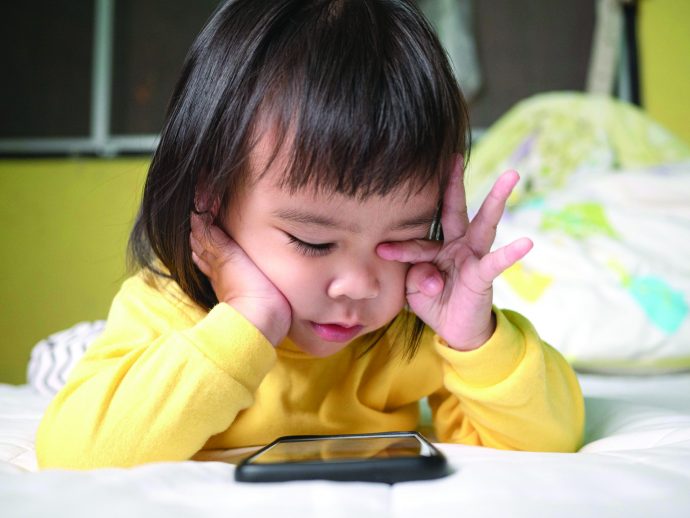As technologies become smarter and more connected, there is little doubt that our lives today are immersed in a digital environment, and our children are truly digital natives.
Coined by American writer Marc Prensky in 2001, the term “digital native” describes a generation of people growing up in the era of ever-present digital technology, who are comfortable with computers at an early age and consider technology a necessary part of their lives. Many teenagers and children are adept at communicating and learning via computers, social networking services, and texting.
However, while technology offers numerous opportunities to digital natives, it also exposes them to many risks. Young people’s reliance on digital technology has given rise to concerns that these technologies and social media are worsening anxiety and depression, disturbing sleep patterns, as well as leading to problems such as cyber-bullying and distorted body image.
Hence, parents need to educate themselves and keep abreast of the latest research and technology so they can adopt an approach that minimises the risks without restricting the opportunities that digital technologies and social media have to offer their children.
When to start?
You may think that living in a digital world has little to no effect on the mental health of young children. But that would be erroneous. Children are spending more time in the digital environment than ever before and at younger ages.
It’s not uncommon to see toddlers glued to a telephone, tablet, or computer screen these days. In fact, research has shown that children have their first experience with digital technologies before turning two, often when they can’t even walk or talk!
According to behavioural psychologist Alexius Cheang, “It is important to understand that current studies have demonstrated the link between excessive screen time and its negative effects on physical and mental development in children, leading to obesity, behavioural issues, anxiety and even depression.”
“For example, spending too much time on devices hinders children from getting the recommended amount of sleep each night, which negatively affects their physical development and also impacts their performance academically, particularly when it cuts into the time they should be devoting to schoolwork,” he continues.
So, when is the best time to introduce your child to digital technology? Some experts feel that children under two should have no screen time at all. Meanwhile, kids between two and five should have no more than one hour per day and for school-going children, no more than two hours per day, apart from homework.
Apart from the when, parents should also give thought to what to start kids off with. “For children between two and five, it would be best to start with high-quality content. That doesn’t mean simply handing your child a device with YouTube, which is a popular platform for both younger and older kids. There needs to be supervision through co-viewing,” says Cheang.
“With thoughtful and supervised use of technology, parents and teachers can engage their children and hone key skills such as self-expression and computational thinking which will inspire curiosity and support success in academic disciplines later on.”
However, while parents may credit YouTube for entertaining and educating their children, there is also a huge concern that children are being exposed to inappropriate content. Do you keep a close eye on your children while they are on YouTube? Do you have any parental controls in place?
How much is too much?
As a parent, are you aware of how much time your children spend on their gadgets?
Data from a National Institutes of Health (NIH) study that began in 2018 in the United States indicates that children who spent more than two hours a day on screen-time activities scored lower on language and thinking tests, and some children with more than seven hours a day of screen time experienced thinning of the brain’s cortex, the area of the brain related to critical thinking and reasoning.
“There have been many studies that have noted how children tend to have a poorer attention span, to the point of having attention deficit, when they are exposed to multiple stimuli at once during screen time, thus conditioning them to shift their attention very quickly between activities,” says Prof Dr Alvin Ng. “Their brains then ‘short circuit’, and that contributes to a lot of learning problems, social difficulties and cognitive fatigue, which in turn may result in emotional problems.”
Prof Ng shares that with rapid technological developments making access to electronic devices pervasive, there are growing concerns about the psychological impact of prolonged screen time, particularly in children and adolescents.
“Childhood and adolescence are sensitive periods in which neurobiological systems are developing, making them particularly vulnerable. Excessive screen time can displace important behaviours such as physical activity, getting adequate sleep, social interactions, and academic activities.”
The clinical psychologist says, “If young children spend most of their time engaging with gadgets like tablets and phones – and this is apparent when we look around us – it can be hard to get them engaged in other activities such as exploring the outdoors and playing with other children to develop social skills.”
Prof Ng is an ardent supporter of green time over screen time. Green time, as the name suggests, is time spent in or exposed to natural environments such as parks, where children can play on the grass and soil, and enjoy the natural sunlight.
Common problems
“Digital devices also come with certain physiological problems. One example is the development of the “text neck syndrome”, which is related to the prolonged posture when reading text messages on the mobile phone. Misuse of earbuds may also be causing damage to your child’s hearing. Plus, too much time on any device can result in a host of problems including sleep deprivation, bad eyesight or hearing, damage to muscles, and others. All of which contribute to a child’s wellbeing,” says Datuk Dr Zulkifli Ismail, Chairman of the Positive Parenting Programme.
There are also social problems associated with media and social media. “Social media is part of everyday life for over 4.6 billion people worldwide. And with social media, young people are bombarded with all sorts of content: fake news, sex, violence and harmful content, which can lead to anxiety, body image problems, depression, suicide and other mental problems,” the consultant paediatrician and paediatric cardiologist adds.
“Parents should also be alert about addiction, be it social media addiction, gaming addiction, porn addiction, gambling addiction, gadget addiction, as these issues are growing more common. On top of this, you also have to be aware of online security and privacy invasion, sexting, sexual predators, scams and the likes. Technology is ever changing, persistently challenging the ability of law enforcements to keep up, let alone parents!”
Parental concerns
Parents are naturally concerned about their children, but as they are not digital natives themselves, they may often lag behind their kids when it comes to tech or digital know-how.
“Researchers have organised the wide range of risks encountered online into three categories: content, contact and conduct. It is good for parents to be aware of these risks so they can watch out for signs that children are in danger,” says Dr Zulkifli.
Content risk describes a child being exposed to inappropriate content, such as pornographic and violent images, or content that promotes dangerous behaviours, such as self-harm and suicide.
Contact risk is when a child befriends or communicates with someone unknown online, possibly leading to risky behaviours. For example, there may be adults out there soliciting a child for sexual purposes.
Conduct risk is when a child behaves inappropriately online, for example, by bullying on writing hateful things about other individuals, or carelessly distributing sexual images of others or even themselves.
Supporting digital natives
If leveraged in the right way, digital technology can be a game changer for children, connecting them to great opportunities and providing them with skills they need to succeed in a digital world. Therefore, it’s important for parents to keep an open mind and not think of digital technology as a bad thing. So how can parents support their children?
While attitudes vary by culture, children often turn first to their peers when they experience risks and harms online, making it harder for parents to protect their children.
“Therefore, one should always practise open communication at home, so that your children make it a habit to discuss what they are seeing and doing online with the family. This could be as simple as making it a practice at dinner time to talk about daily activities, including what they are doing online and how much time they are spending on their devices,” says Dr Zulkifli.
Prof Ng agrees, saying that parents and kids should always have open channels of communication and a safe space to share and discuss latest trends and developments without judgement. “Above all, parents need to also acknowledge the amount of time they themselves are spending on their devices. We need to be aware of our own actions and be role models ourselves.”
Thanks to digital technology, there are wellness apps, easy access to information, support groups and self-help videos which have made it easy for children and youths to get help when they need it. Online communities are also quickly becoming the gateway for youth to learn about mental health. In this day, even remote treatment and consultation is available.
However, Cheang reminds parents that they should advise their children on choosing the right platform. “Websites and wellness apps need to be assessed for accuracy and evidence. Look for sites that show references, and always go the extra mile to check sources and compare findings,” he advises.
As a parent, you can also take advantage of parental control devices, monitoring apps and features on your child’s phone or computer to keep them safe and help them develop a balanced lifestyle. “With monitoring apps in place, you can better understand usage patterns and later have discussions based on recommended guidelines,” Cheang says.
Families can provide support by having joint screen time activities and co-viewing sessions. Co-viewing has a range of positive effects, including supporting early literacy skills, boosting empathy, and managing aggression after exposure to violent media.
“You can also play online games together. This way, parents can better understand what is attractive to their kids and also have a common language to communicate with them as you learn to understand their lingo via the games,” Cheang says.
He also adds that parents should also befriend or follow their children’s Facebook, Instagram and even TikTok. “Children will be more mindful of what they post online if they know their parents are likely to see it too,” says Cheang.
Last but not least, encourage activities outside the home, so that your children have enough green time, exercise and socialisation. “Keep in mind that these activities should be children-centred. This means, the activity has to be something that they like to do, for example, ice skating, playing in the park, or going to a petting zoo, instead of what you would like to do,” explains Cheang.
Raising children today is hugely different from how your parents may have raised you. However, the digital world is unavoidable nowadays. Hence, a balance between online life and real life is healthy and necessary.
If parents make the effort to keep up to date with research, and then make time to supervise, communicate and educate their children, they will be able to mitigate the harms, nurture children’s mental health and wellbeing, and expand the opportunities digital technology makes possible for children everywhere.







Comments